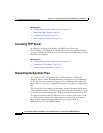
Chapter 2 Preparing to Install the Cisco IP Phone on Your Network
Understanding the Phone Startup Process
2-6
Cisco IP Phone Administration Guide for Cisco CallManager 3.3, Cisco IP Phones 7902G/7905G/7912G
OL-6313-01
Related Topics
• Understanding the Phone Startup Process, page 2-4
• Modifying DHCP Settings, page 4-9
• Configuring IP Settings, page 4-15
• Resolving Startup Problems, page 6-12
Accessing TFTP Server
In addition to assigning an IP address, the DHCP server directs the
Cisco IP Phone to a TFTP Server. If the phone has a statically defined IP address,
you must configure the TFTP server locally on the phone; the phone then contacts
the TFTP server directly.
Related Topics
• Understanding the Phone Startup Process, page 2-4
• Configuring TFTP Options, page 4-28
• Resolving Startup Problems, page 6-12
Requesting Configuration Files
The TFTP server has configuration files (.cnf file format or .cnf.xml) for
telephony devices, which define parameters for connecting to Cisco CallManager.
In general, any time you make a change in Cisco CallManager that requires the
phone (device) to be reset, a change has been made to the phone's configuration
file.
The .cnf.xml file also contains the information that tells the phone which image
load it should be running. If this image load differs from the one currently loaded
on the phone, the phone contacts the TFTP server to request the new image file.
The phone first requests the file SEPxxxxxxxxxxxx.cnf.xml, where each xx is the
two-digit lowercase hexadecimal representation of each integer in the phone’s
MAC address. If the phone cannot find this file, it requests the files
XMLDefault.cnf.xml and SEDDefault.cnf.


















